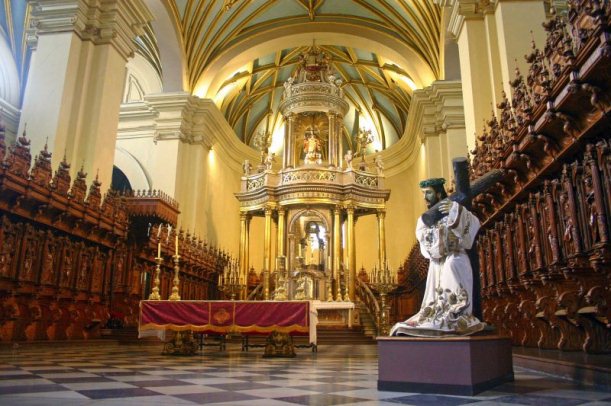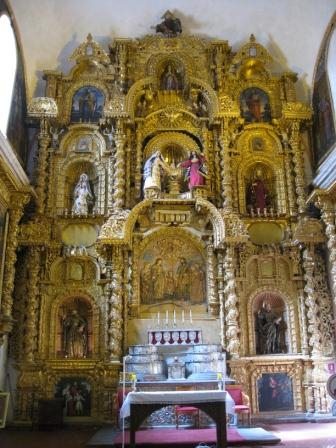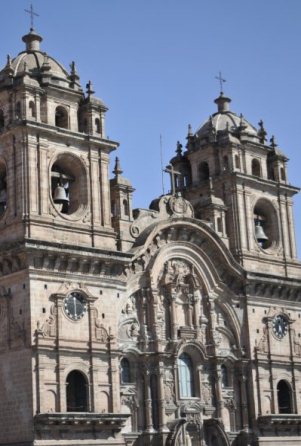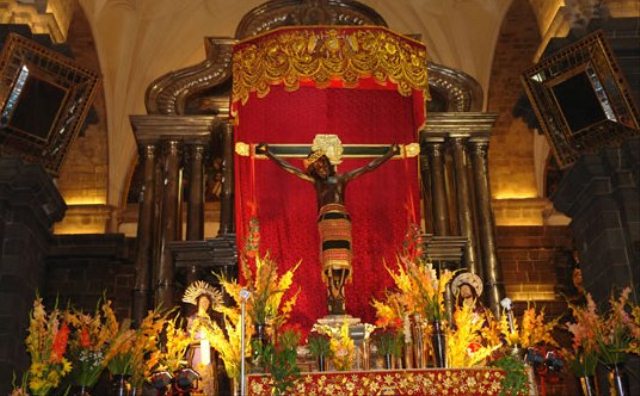The Cathedral

|
The Santo Domingo Cathedral,
Cuzco
We walked over to the Cathedral to meet our guide Fernando at two o’clock. The Cathedral of Santo Domingo in Cuzco is set on the main square of the Plaza de Armas, voted in the top six Cathedrals in the world in terms of paintings, frescos, statues and sheer weight of gold leaf and silver. The building was completed in 1654, one hundred and thirty seven years after construction began – ninety five in building the rest in decorating. Adjacent and joined to the cathedral is the smaller ‘Iglesia del Triunfo’, which was the first Christian church to be built in Cuzco. The Iglesia de la Compania de Jesus’ that dominates the plaza, was built at a similar time to the cathedral. The cathedral, as well as its official status as a place of worship, has become a major repository of Cuzco’s colonial art, holds many artefacts and relics. The cathedral has UNESCO World Heritage status under the City od Cuzco listing in 1983. Located at thirteen degrees, thirty one minutes South. Seventy one degrees, fifty eight minutes point seven West.
History: Kiswar Kanchar - Preceding the construction of the Cathedral was 'Kiswarkanchar,' on the foundations of which Santo Domingo was built. Kiswarkanchar was the Inca palace of Viracocha, (the king of Cuzco around a century before the Spanish discovered Cuzco) who was named after Viracocha, the creator figure in Inca Mythology. Near to the Kiswarkanchar was the 'Suntur Wasi,' which was an armoury and heraldry centre for the Inca royalty. When the Spanish Conquistadores arrived in Cuzco, the palace of Viracocha was identified as a location for a Catholic cathedral, and therefore Kiswarkanchar was destroyed. The Cathedral's construction began in 1559, and the foundations of Kiswarkanchar were used as foundations for the Latin cross-shaped cathedral. The location of Viracocha's palace was chosen for the purpose of removing the Inca religion from Cuzco, and replacing it with Spanish catholic Christianity. Due to the fact that 1559 was only twenty six years after the conquistadores entered Cuzco in 1533, the vast majority of the population was still of Quechua Inca descent. Therefore, as the Spaniards had assumed power over the Cuzco populace, the Incas were used as a labour workforce to build the Cathedral.  The original designs for the one acre large construction were drawn
by the Spanish architect and conquistador, Juan Miguel de Veramendi. His design of a Latin cross shape
incorporated a three-aisled nave, which was held up by only fourteen pillars. Over the ninety five years of its construction, the building work
was supervised by more Spanish priests and architects, until its completion in 1654. Most of the stones from the building
were taken from Saqsaywaman, an Inca holy and defensive structure located on the hills above Cuzco, although due to the large size of Saqsaywaman, a considerable proportion of the site remains intact, again proof
that the Spaniards would do anything to destroy the Inca heritage. The local
workers carved large male members at the hand holds of the choir with a set of
subtle rounded breasts at the top - for fertility and virility. We wondered if
the dead saints carved at the head rests approved and how many dignitaries ever
twigged.
Architecture: The gothic-renaissance style of architecture employed in the design
of the cathedral reflects that of Spain during the period of the Spanish conquest of South
America and also Cuzco. There is also evidence of a baroque influence in the magnificent
facade facing onto the Plaza
de Armas. Due to the resentful feelings felt by the conquered Incas towards the
Spaniards, the Inca workforce incorporated much of their religious symbolism into the
construction of the cathedral, for example, the carved head of a puma (an
important god or religious motif found widely through much of ancient
Peru) on the cathedral doors.
  The Artifacts: There are many holy Christian artifacts within the Cathedral, some of which are incredibly fine
pieces of antique colonial craftsmanship. Here is a list of some of these:
Altar. There are two altars in the cathedral,
the original lambran (alder-tree) one at the very back, and in front of that,
the neoclassical beaten embossed silver altar being used at the time, weighing eight hundred and fifty
kilograms. The silver altar was originally cedar
wood covered in gold flakes, but in 1803 (according to the inscription on the front of
the silver panel), Heras Bishop donated the silver to be beaten and applied to the altar.
Maria Angola Bell. The right tower of the cathedral
supports the famous 'Maria Angola,' a bell that is seven feet high, and weighs approximately 5980kgs. Cast in
1659, and named, according to local tradition, after an Angolan slave who threw
gold into the crucible where the bell was being made. Today, the bell is cracked
and is only rung on special occasions, although it has been claimed that it was
once heard ringing from over twenty miles away.
The sacristy, a highly decorated part of the cathedral, displays a large
collection of allegoric paintings by Marcos Zapata from the 18th
century. Also, there are many portraits of Cusco's bishops, beginning with Vicente de Valverde (see 'artwork'), who
was the very first resident bishop of Cusco. Within the sacristy, a large, dark painting of the crucifixion that is commonly
attributed to the Dutch artist, Anthony Van Dyck, despite the claims of some local guides
who believe it is the work of the Spanish Alonso Cano, from the 17th
century.
 Black Christ. This wooden figure is black from centuries of smoke, dust and the
honeysuckle petals thrown during two weeks each year at processions, rather than
being connected with the race
of Jesus but 95% of the population of Cuzco took him to heart as he
was their colour. The Black Christ was not cleaned during restoration of the
cathedral interior in the 1990’s, when the burning of candles ceased. The
crucifix is taken outdoors each year as the focus of the Lord of Miracles
Procession in October, in commemoration of the 1650 earthquake.
Artwork: Much of the artwork in the cathedral originated from the 'Escuela
Cuzquena,' (Cuzco
school) of art. This was a school that was built by the Spanish to educate the Incas and their descendants with the methods and disciplines of
European renaissance style artwork. This school was famous throughout the colonial Americas, but the
Quechua painters were limited to painting scenes of European and
Catholic importance. The restrictions imposed on the Inca artists meant that they were not permitted to sign their own
artwork, so much of it is unidentifiable. Here is a list of some of the most
notable pieces found within the cathedral: Pintura Senor de los Temblores. The oldest surviving painting in Cuzco, which depicts the whole of the ancient city during the 1650
earthquake. Many of the townspeople can be seen carrying a crucifix around the
Plaza
de Armas, praying for the tremor to end. Vicente de Valverde. A portrait of the friar who became a bishop at Cuzco, after accompanying Francisco
Pizarro on his conquests.
Christ's Twelve Parables. An incomplete collection of twelve paintings by the Quechuan artist
Diego Quispe T'ito. There were initially twelve canvases (completed in 1681) to
depict the twelve months and zodiac symbols of the year, incorporating the
parables of Jesus into the pictures.

|